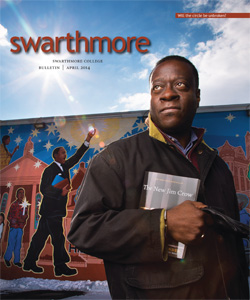Dramatic Visionary, Brilliant Director
Rhythmic innovations, seamless transitions typify Mamoulian style
Joseph Horowitz ’70, “On My Way”: The Untold Story of Rouben Mamoulian, George Gershwin, and Porgy and Bess, W.W. Norton and Co., New York, 2013, 304 pp.
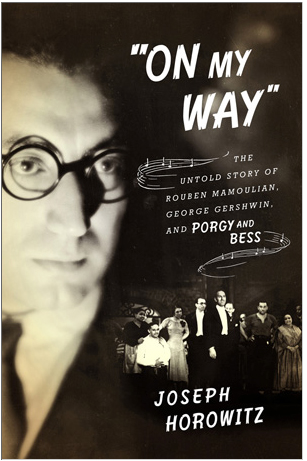
Musical theater productions in America typically come to life in a creative frenzy of collaboration, usually in
hurried preparation for a New York debut. While the names of composer, lyricist, and original stars are immortalized on marquees and cast albums, many other creative personalities help to shape a musical at its inception but gradually are forgotten. Trude Rittman, the composer and conductor whose inspired transformations of Richard Rodgers’ tunes are heard throughout South Pacific (and many other shows) as dramatic underscoring, comes to mind. I find it difficult to imagine the characters Nellie Forbush and Emile de Becque falling in love without Rittman’s inspired contributions.
Joseph Horowitz’s evocative new book, “On My Way”: The Untold Story of Rouben Mamoulian, George Gershwin, and Porgy and Bess, shines a light on another neglected figure from musical theater’s golden age. Rouben Mamoulian made his directorial mark in the 1920s with intensely concentrated productions, often driven by precisely designed rhythmic and kinetic stylization. (In addition to Porgy and Bess, Mamoulian also directed the first productions of Oklahoma! and Carousel). By focusing on Mamoulian’s work as the stage director of both the play Porgy (1927) and its 1935 musical adaptation (Porgy and Bess), Horowitz reveals Mamoulian not only as the dramatic visionary who saw the original productions through to unified performances, but as an important designer of the tone and shape for both works.
Horowitz’s descriptions of Mamoulian’s stagings of the play and the opera are tantalizing. The original productions were never filmed, but Horowitz, in rhythmic, imaginative prose, carefully pieces together contemporary accounts, interviews, photographs, and Mamoulian’s production notes to arrive at vivid theatrical descriptions.
As a sound designer 40 years before the term was invented, Mamoulian was particularly innovative. He used noise as a rhythmic undergirding for dramatic action, and the careful manipulation of sound and tempo became a Mamoulian trademark. (Mamoulian directed rehearsals with a metronome and baton!)
Though the precise rhythms of the original stage productions may be lost to us, Horowitz helps us imagine the effect by examining the similarities between Mamoulian’s Porgy staging and one of his first films, the 1932 musical Love Me Tonight. In a detailed analysis of the film’s opening sequence (which is readily available on YouTube), Horowitz gives us a taste of how Mamoulian’s rhythmic innovations and seamless transitions might have been realized on stage.
Mamoulian developed these rhythmic principles in his early years directing opera in Rochester, N.Y., which in the 1920s was a hub of experimental artistic activity funded by George Eastman, founder of the Eastman Kodak Co. Horowitz’s accounts of these bold productions (some of which premiered, one act at a time, between screenings of silent movies) make for inspiring reading. These years of intense collaboration and experimentation remind me of the Festival of the Creative Arts founded by Leonard Bernstein at Brandeis University in the early 1950s: In both cases the seeds of cultural innovation were sown far from the commercial pressures of the New York stage in an environment that was enriched by maverick minds who embraced what Horowitz terms “cultural fluidity.”
Horowitz convincingly links Mamoulian’s early Rochester direction of Maurice Maeterlinck’s morality play Sister Beatrice with his later work, particularly with Porgy. He credits Mamoulian with transforming the “local and resigned” tone of DuBose Heyward’s 1925 novel Porgy into a play at once “epic and sanguine.” (The same tone was adopted in the operatic version.)
While Mamoulian’s direction often took liberties with the text, his changes to the ending of Porgy are downright authorial. By “recasting the novella’s dour ending as a redemptive mass finale, Mamoulian nudged Porgy toward a ‘miracle play’ paradigm,” writes Horowitz. Vital changes were made to the original script in Mamoulian’s hand, including many of the final scene’s most powerful lines (particularly memorable once George Gershwin set them to music). Beyond the brilliant direction of the original production, Mamoulian is, in the end, responsible for the redemptive tone of both play and opera.
—Andrew Hauze ’04, associate in performance, is a conductor, pianist, and organist, who has taught at Swarthmore since 2006.
Books
Peter Blair ’73, Congress’s Own Think Tank: Learning from the Legacy of the Office of Technology Assessment (1972–1995), Palgrave Macmillan, 2013; 128 pp. This book discusses Congress’ establishment of the nonpartisan Office of Technology Assessment in 1972 and its 23–year-long analysis of major public policies on issues including energy, space, health, among others.
Leo Braudy ’63, Trying to be Cool: Growing up in the 1950s, Asahina and Wallace, 2013; 269 pp. This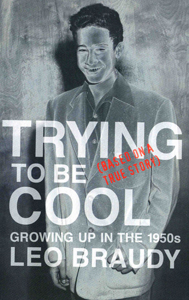 memoir, a work that fellow writer Percival Everett ironically praises as “so damn cool,” takes readers through the bold teenage social landscape unique to Philadelphia in the 1950s.
memoir, a work that fellow writer Percival Everett ironically praises as “so damn cool,” takes readers through the bold teenage social landscape unique to Philadelphia in the 1950s.
Ellen Brown ’80, Master Kierkegaard: The Complete Journals, Cascade Books, 2013; 214 pp. These fictional journals of Magda, a servant in the house of Danish philosopher Søren Kierkegaard, reflect her thoughts on secular and sacred writings, interactions with her master, and the changing social landscape. At the same time, Kierkegaard works on his own writings.
Robin Chapman ’64, Dappled Things, Revue K, 2013; 53 pp. Chapman, a fan of pairing art forms and who posts her watercolor artwork along with her poetry online, tastefully partners each of her poems with one of artist Peter Miller’s photogravure etchings.
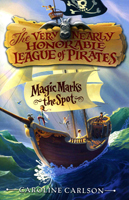 Caroline Carlson ’06, The Very Nearly Honorable League of Pirates: Magic Marks the Spot, HarperCollins,2013; 344 pp. Denied the chance to be a pirate by The Very Nearly Honorable League of Pirates, because she is a girl, Hilary Westfield takes to the seas anyway, chasing her dream of adventure and finding treasure.
Caroline Carlson ’06, The Very Nearly Honorable League of Pirates: Magic Marks the Spot, HarperCollins,2013; 344 pp. Denied the chance to be a pirate by The Very Nearly Honorable League of Pirates, because she is a girl, Hilary Westfield takes to the seas anyway, chasing her dream of adventure and finding treasure.
John Halbert ’89, Irish and American Colors & Fires, Create Space Independent Publishing Platform, 2013; 39 pp. With this collection of poems, ranging from serious, political, and philosophical to surreal, Halbert invites readers to enjoy his experiments with language and nourish their imaginations.
Ellen NicKenzie Lawson ’66, Smugglers, Bootleggers, and Scofflaws: Prohibition and New York City, State University of New York Press, 2013; 158 pp. Lawson documents the means by which New York City steadfastly maintained its status as America’s greatest liquor market during Prohibition.
Cathy Chaplin ’04, Food Lovers’ Guide to Los Angeles: The Best Restaurants, Markets & Local Culinary Offerings, Globe Pequot Press, 2014; 356 pp. Engagingly written, this book is the ideal accessory for a gastronomical tour of all that Los Angeles cuisine has to offer: its restaurants, food festivals, sweet shops, and more.
Offerings, Globe Pequot Press, 2014; 356 pp. Engagingly written, this book is the ideal accessory for a gastronomical tour of all that Los Angeles cuisine has to offer: its restaurants, food festivals, sweet shops, and more.
Ford O’Connell ’00, Hail Mary: The 10-Step Playbook for Republican Recovery, CreateSpace Independent Publishing Platform, 2013, 138 pp. Engagingly written, this book provides 10 steps to revive the Republican Party.
Daniel Park ’93, The Legal Mind: How the Law Thinks, CreateSpace Independent Publishing Platform, 2013; 322 pp. Via a rare trifecta of knowledge, clarity, and wisdom, Park throws light on the seemingly alien workings of the legal system in a way that author David Eagleman compares to “the sudden clarification of a friend’s behavior.”
Sarah Jaquette Ray ’98, The Ecological Other: Environmental Exclusion in American Culture, The University of Arizona Press, 2013; 211 pp. In this examination of environmentalism, the author challenges readers to question which cultural identifiers (e.g., race, gender) have been excluded from national discussions on the environment.
 Walter Clark Jr. ’54, Like a Bird Flying Home: Poetry & Letters to His Daughter from New Hampshire, Bauhan Publishing, 2013; 159 pp. This posthumously published book of letters and poems eloquently depicts Clark’s life and allows readers to delve deeper into his enlightenment.
Walter Clark Jr. ’54, Like a Bird Flying Home: Poetry & Letters to His Daughter from New Hampshire, Bauhan Publishing, 2013; 159 pp. This posthumously published book of letters and poems eloquently depicts Clark’s life and allows readers to delve deeper into his enlightenment.
Robin Ridington ’62 and Jillian Ridington, Where Happiness Dwells: A History of the Dane-zaa First Nations, UBC Press, 2013; 402 pp. Recounting 50 years of fascinating oral histories, the author presents a history of the Dane-zaa people of British Columbia’s Peace River area while highlighting the importance of storytelling to these people and its modern-day endangerment. (For more on the Ridingtons’ work, see Page 70.)
Shanna Rose ’97, Financing Medicaid: Federalism and the Growth of America’s Health Care Safety Net, The University of Michigan Press, 2013; 313 pp. Through detailed and careful analysis, the author show how 50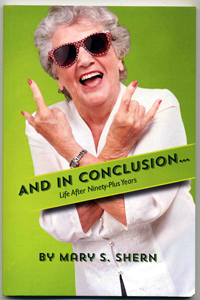 years of lobbying by state governors of both parties enabled Medicaid to develop into the most widespreadU.S. health-insurance program.
years of lobbying by state governors of both parties enabled Medicaid to develop into the most widespreadU.S. health-insurance program.
Shalom Saada Saar ’74, Leading with Conviction: Mastering the Nine Critical Pillars of Integrated Leadership, Jossey-Bass, 2013; 253 pp. Swarthmore President Rebecca Chopp applauds this book for its “priceless metaphors and enduring pillars as milestones” that serve “as a companion and guide to the well-lived life that is leadership.”
Mary Shern ’42, And In Conclusion … : Life After Ninety-Plus Years, CreateSpace Independent PublishingPlatform, 2013; 108 pp. Enjoy the author’s hilarious reflections and personal anecdotes on dotage in the digital age, along with amusing illustrations by Alan Low.
 Email This Page
Email This Page